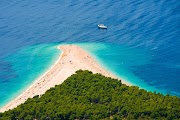Brač is famous for two things: its radiant white stone, used to build Diocletian’s Palace in Split (and, depending on whom you believe, the White House in Washington) and Zlatni Rat, the pebbly beach at Bol that extends languidly into the Adriatic and adorns 90% of Croatia’s tourism posters.
Blaca Hermitage
Things can't have looked too different on the approach to this remote mountain cleft when a small group of priests and their servants, on the run from the Ottoman Turks on the mainland, arrived here in 1551. They initially took shelter in a cave (the walls of which are still visible in the kitchen) and built out from there. You can now take an informative 30-minute tour of the complex, which is full of original furniture, tools, and rare manuscripts.
By the 18th century, the hermitage ministered to three remote villages, with the priests operating a school from one of the rooms. The school closed in 1963 with the death of the hermitage's last resident priest, the extraordinary Fr Nikola Miličević, who was also a poet and an astronomer of international repute.
The journey is a large part of the experience, involving a rough drive along a narrow, unsealed road and then a 2.5km walk down a steep path (good shoes are recommended). The turnoff is well signposted from the main road southeast of Nerežišća; it's the same turnoff as for the Vidova Gora lookout, and the two can easily be combined into one trip. Alternatively, you can arrange a boat from Bol to the bottom of the valley and take a somewhat longer walk up. Enquire at the tourist office in Bol about tours.
Church of the Annunciation
Built in the 18th century, this elegant triple-naved baroque church and its 35m-high bell tower dominate the historic harbor at the heart of Supetar. Inside, its ornate marble altars are offset by a soothing palette of pale greens and lemons. Set into the pavement to the left of the church is a Roman mosaic that once decorated the floor of an early basilica dedicated to St Peter, from which the town takes its name.
Overlooking the mosaic is a statue of St Teresa of Calcutta (aka Mother Teresa) that was unveiled in 2002 by American actor Martin Sheen, who was filming in Brač at the time.
Dominican Monastery
Positioned at the end of a pretty pebbly beach, this monastery was founded in 1475, but it's far from the oldest structure on the site; the little chapel by the beach was built in the 9th or 10th century on 6th-century foundations. Although it's often closed, the main church has a magnificent altar painting from the workshop of Venetian superstar Tintoretto. There's also a museum displaying rare manuscripts, coins, liturgical items, and archaeological finds.
Museum of the island of Brač
Brač Museum is housed in the Kaštil Radojković, a fortification built during the Venetian-Turkish wars that incorporates part of an ancient Illyrian wall and an extraordinary Roman mausoleum. The collection includes household objects, farm implements and some rather more interesting ancient Roman carvings.
Branislav Dešković Art Gallery
Housed in a Renaissance-baroque town house right on the seafront, this excellent gallery displays paintings and sculptures by 20th-century Croatian artists. It's a surprisingly prestigious collection for such a small town, including works by such luminaries as sculptor Ivan Meštrović and expressionist painter Ignjat Job. The gallery is named after Brač-born Dešković (1883–1939), a sculptor who became famous for his depictions of animals – look for his Scratching Dog in the courtyard.






0 Comments